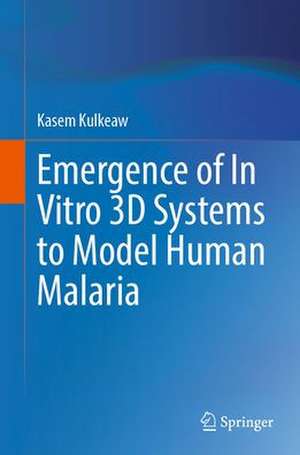Emergence of In Vitro 3D Systems to Model Human Malaria
Autor Kasem Kulkeawen Limba Engleză Hardback – 30 mai 2023
Preț: 778.13 lei
Preț vechi: 948.95 lei
-18% Nou
Puncte Express: 1167
Preț estimativ în valută:
148.89€ • 155.87$ • 123.20£
148.89€ • 155.87$ • 123.20£
Carte tipărită la comandă
Livrare economică 05-19 aprilie
Preluare comenzi: 021 569.72.76
Specificații
ISBN-13: 9789819906901
ISBN-10: 9819906903
Ilustrații: XI, 94 p. 1 illus.
Dimensiuni: 155 x 235 mm
Greutate: 0.33 kg
Ediția:2023
Editura: Springer Nature Singapore
Colecția Springer
Locul publicării:Singapore, Singapore
ISBN-10: 9819906903
Ilustrații: XI, 94 p. 1 illus.
Dimensiuni: 155 x 235 mm
Greutate: 0.33 kg
Ediția:2023
Editura: Springer Nature Singapore
Colecția Springer
Locul publicării:Singapore, Singapore
Cuprins
Chapter 1_Introduction to malaria biology in a liver.- Chapter 2_Modeling a liver-stage malaria.- Chapter 3_Liver organoid and liver-on-a-chip.- Chapter 4_Generation of liver organoid.- Chapter 5_Generation of liver-on-a-chip.- Chapter 6_The use of 3D in vitro systems to model human malaria.
Notă biografică
Dr. Kasem Kulkeaw is a director of the Siriraj Integrative Center for Neglected Parasitic Diseases at the Faculty of Medicine Siriraj Hospital, Mahidol University in Thailand. He has earlier served as a visiting scientist under “Exchange Program for East Asia Young Researchers” of the Japan Society for Promotion of Science at Kyushu University, Japan; an assistant professor in the Department of Research and Development of Next Generation Medicine, Faculty of Medical Sciences, Kyushu University, Japan (2014–2018; and assistant professor at the Department of Parasitology at Mahidol University, Thailand (2021–present). His research interest is in cell biology and molecular biology specializing in stem cell-based disease models, cell differentiation of pluripotent stem cells, and malaria biology. He has been conferred with various prestigious fellowships, notably, the Royal Golden Jubilee PhD program of Thailand Research Fund (2002–2008), the postdoctoral fellowship of Ajinomoto Scholarship Foundation (2009–2010), the postdoctoral fellowship of the Tokyo Biochemical Research Foundation (2010–2012), and the postdoctoral fellowship of the Japan Society for the Promotion of Science (2012–2014). He has more than 10 years of research experience in cell biology, stem cell science, and animal ethics, and more than 3 years of teaching experience in stem cell biology and medical parasitology. Since 2008, he has also published more than 30 research articles and 5 review articles in peer-reviewed international journals.
Textul de pe ultima copertă
This book illustrates the importance and advances of the disease model for malaria, a globally affected public health problem. This book provides comprehensive information on the malaria biology in a liver and all in vitro platforms for liver-stage malaria, including principles, protocols, applications for disease modeling and drug screening, and their limitations. The initial chapter describes the basis of stem cells in liver generation during development and in adults. The subsequent chapters highlight recent and emerging advances in liver organoid and liver-on-a-chip in modeling malaria. The book presents current protocols and methods to generate liver organoid and liver-on-a-chip together with their advantages and limitations. Toward the end, the book examines the humanized mouse model of liver-stage malaria using ectopic artificial livers regarding novel readout modalities. The recent advancement and challenges in combining liver-on-a-chip technology with biosensors are highlighted for assessing hepatocyte development viability and functions. The book elucidates the potential of these 3D models to understand the biological complexity of cellular and molecular mechanisms involved in Plasmodium development in the liver, toolboxes to investigate parasite deployment in the 3D models, and to implement in drug discovery. Finally, the book discusses the future directions and challenges in the applications of liver organoids and liver on-chip in the biology of live-stage malaria. This book is helpful for researchers and scientists in the field of parasitology, cell biology, tissue engineering, and pharmacology.
Caracteristici
Explores the applications of liver organoids for modeling human diseases Illustrates the potential applications of in vitro 3D models for malaria research Presents in-depth protocols and methods for liver organoid generation
